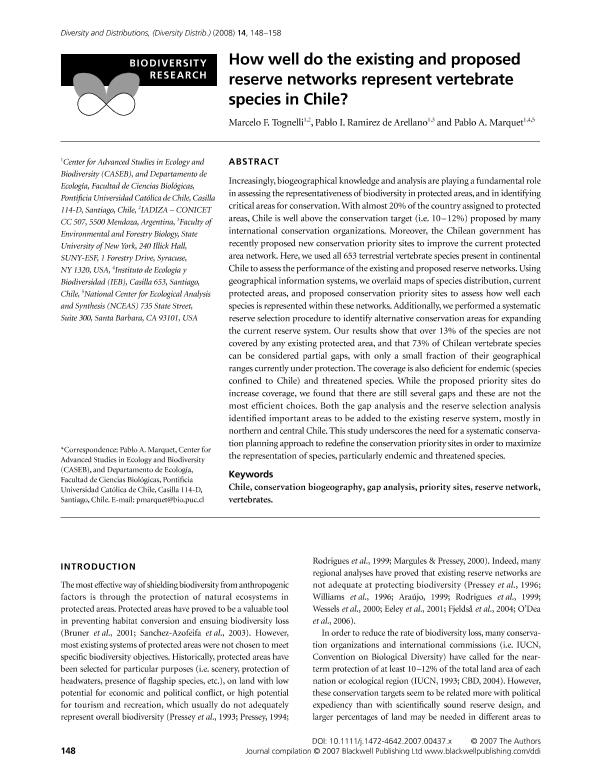Mostrar el registro sencillo del ítem
dc.contributor.author
Tognelli, Marcelo Fabio

dc.contributor.author
De Arellano, Pablo I. Ramirez
dc.contributor.author
Marquet, Pablo A.
dc.date.available
2019-12-23T18:07:44Z
dc.date.issued
2008-01
dc.identifier.citation
Tognelli, Marcelo Fabio; De Arellano, Pablo I. Ramirez; Marquet, Pablo A.; How well do the existing and proposed reserve networks represent vertebrate species in Chile?; Wiley Blackwell Publishing, Inc; Diversity and Distributions; 14; 1; 1-2008; 148-158
dc.identifier.issn
1366-9516
dc.identifier.uri
http://hdl.handle.net/11336/92822
dc.description.abstract
Increasingly, biogeographical knowledge and analysis are playing a fundamental role in assessing the representativeness of biodiversity in protected areas, and in identifying critical areas for conservation. With almost 20% of the country assigned to protected areas, Chile is well above the conservation target (i.e. 10-12%) proposed by many international conservation organizations. Moreover, the Chilean government has recently proposed new conservation priority sites to improve the current protected area network. Here, we used all 653 terrestrial vertebrate species present in continental Chile to assess the performance of the existing and proposed reserve networks. Using geographical information systems, we overlaid maps of species distribution, current protected areas, and proposed conservation priority sites to assess how well each species is represented within these networks. Additionally, we performed a systematic reserve selection procedure to identify alternative conservation areas for expanding the current reserve system. Our results show that over 13% of the species are not covered by any existing protected area, and that 73% of Chilean vertebrate species can be considered partial gaps, with only a small fraction of their geographical ranges currently under protection. The coverage is also deficient for endemic (species confined to Chile) and threatened species. While the proposed priority sites do increase coverage, we found that there are still several gaps and these are not the most efficient choices. Both the gap analysis and the reserve selection analysis identified important areas to be added to the existing reserve system, mostly in northern and central Chile. This study underscores the need for a systematic conservation planning approach to redefine the conservation priority sites in order to maximize the representation of species, particularly endemic and threatened species.
dc.format
application/pdf
dc.language.iso
eng
dc.publisher
Wiley Blackwell Publishing, Inc

dc.rights
info:eu-repo/semantics/openAccess
dc.rights.uri
https://creativecommons.org/licenses/by-nc-sa/2.5/ar/
dc.subject
CHILE
dc.subject
CONSERVATION BIOGEOGRAPHY
dc.subject
GAP ANALYSIS
dc.subject
PRIORITY SITES
dc.subject
RESERVE NETWORK
dc.subject
VERTEBRATES
dc.subject.classification
Estudios Urbanos

dc.subject.classification
Geografía Económica y Social

dc.subject.classification
CIENCIAS SOCIALES

dc.title
How well do the existing and proposed reserve networks represent vertebrate species in Chile?
dc.type
info:eu-repo/semantics/article
dc.type
info:ar-repo/semantics/artículo
dc.type
info:eu-repo/semantics/publishedVersion
dc.date.updated
2019-10-10T19:35:07Z
dc.journal.volume
14
dc.journal.number
1
dc.journal.pagination
148-158
dc.journal.pais
Reino Unido

dc.journal.ciudad
Londres
dc.description.fil
Fil: Tognelli, Marcelo Fabio. Consejo Nacional de Investigaciones Científicas y Técnicas. Centro Científico Tecnológico Conicet - Mendoza. Instituto Argentino de Investigaciones de las Zonas Áridas. Provincia de Mendoza. Instituto Argentino de Investigaciones de las Zonas Áridas. Universidad Nacional de Cuyo. Instituto Argentino de Investigaciones de las Zonas Áridas; Argentina. Pontificia Universidad Católica de Chile; Chile
dc.description.fil
Fil: De Arellano, Pablo I. Ramirez. Pontificia Universidad Católica de Chile; Chile. State University of New York; Estados Unidos
dc.description.fil
Fil: Marquet, Pablo A.. Instituto de Ecologia y Biodiversidad, Santiago; Chile. Pontificia Universidad Católica de Chile; Chile. National Center For Ecological Analysis And Synthesis; Estados Unidos
dc.journal.title
Diversity and Distributions

dc.relation.alternativeid
info:eu-repo/semantics/altIdentifier/doi/http://dx.doi.org/10.1111/j.1472-4642.2007.00437.x
dc.relation.alternativeid
info:eu-repo/semantics/altIdentifier/url/https://onlinelibrary.wiley.com/doi/full/10.1111/j.1472-4642.2007.00437.x
Archivos asociados
